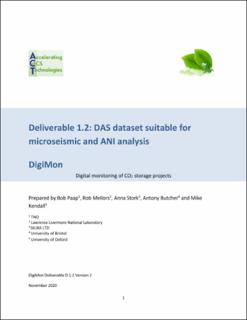| dc.description.abstract | Deliverable 1.2 concerns a DAS dataset suitable for microseismic and ambient noise interferometry (ANI). For this deliverable the DAS field dataset of FORGE is recommended. FORGE is the Frontier Organization For Research in Geothermal Energy, and is a field laboratory for developing an enhanced geothermal system in hot crystalline rock situated near the town of Milford in Utah, USA (https://utahforge.com/). The FORGE team is led by Joe Moore of Utah (and funded by the US Department of Energy) and is credited for this dataset. The dataset is completely open access, but obviously attribution would be appreciated in any publications.
The FORGE dataset applies for deliverable 1.2, because it provides downhole DAS and geophone recordings of microseismic events, and covers approximately two weeks of continuous DAS recordings that can be used to test the potential of DAS for the ANI method.
In addition to the FORGE dataset, various other DAS datasets have recently become publicly available that are recommended to consider as well for further work in task 1.3 and associated tasks, since they can be valuable in addressing different research aspects of the application of DAS. Table 1.1 gives a summary of the different open access datasets considered for this deliverable. This table also shows whether the datasets are suitable to be used for microseismic and ANI analysis. With this application in mind for deliverable 1.2, and when compared against alternative datasets (see Table 1.1), the FORGE dataset is considered to be especially relevant for this deliverable, since it provides both microseismic event data and continuous DAS recordings from a borehole configuration spanning a relatively long duration (17 days). The borehole configuration is preferable for the purpose of detecting micro-seismicity since it allows measurements close to the reservoir and therefore able to detect weaker events compared to a trenched deployment at the surface. FORGE concerns an enhanced geothermal system and in this setting the mechanism driving seismicity is different compared to the case of CO2 injection and storage (DIGIMON). However, the performance of the DAS cable with respect to detected seismicity is expected to be similar for the case of monitoring CO2 injection and storage as in a geothermal setting and therefore the FORGE dataset is expected to be suited for this purpose. | en_US |
